It is the end of the year and the end of the decade; time to review the top stories of the year.
In the past I have relied on the Associated Press’ list of the top ten stories. This year the story came from the national bureau. The State’s AP bureau was recently reduced in size and I would contend that the absence of the list is just one of the examples of the diminished service.
So I offer my list of top stories for the year; I present them in no particular order.
 Albuquerque Mayoral Election
Albuquerque Mayoral Election Albuquerque voters on October 6, 2009, elected their first Republican Mayor since Harry Kinney completed his second term in office in November 1985. State Representative Richard “R.J.” Berry defeated three-term Mayor Martin J. Chávez, below left, and fellow Democrat, former State Senate Pro Tem Richard Romero, right.
Albuquerque voters on October 6, 2009, elected their first Republican Mayor since Harry Kinney completed his second term in office in November 1985. State Representative Richard “R.J.” Berry defeated three-term Mayor Martin J. Chávez, below left, and fellow Democrat, former State Senate Pro Tem Richard Romero, right.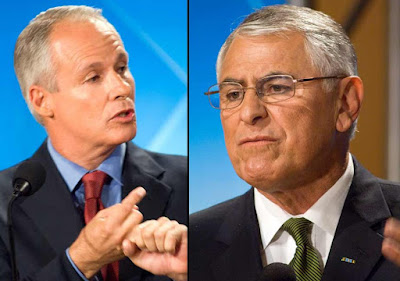 Needing more than 40 percent of the ballots cast to avoid a run-off, Berry secured 40.83 percent surprising not only his opponents, but many long time political observers. Chávez received 35.02 percent and Romero collected 20.98 percent.
Needing more than 40 percent of the ballots cast to avoid a run-off, Berry secured 40.83 percent surprising not only his opponents, but many long time political observers. Chávez received 35.02 percent and Romero collected 20.98 percent.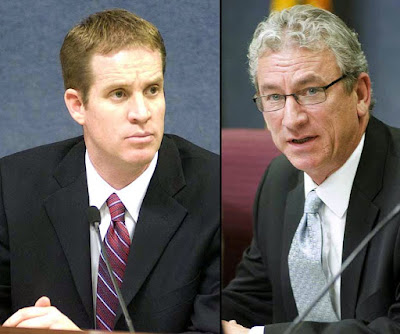 Two new City Councillors were elected, Dan Lewis, left, defeated incumbent Michael Cadigan in District 5 while Michael Cook was elected in District 7 after incumbent Sally Mayer withdrew from the race. Three other incumbents were reelected: District 1 Councillor Ken Sanchez was unopposed, District 3 Councillor Isaac Benton defeated former Councillor and current term-limited County Commissioner Alan Armijo, and District 9 Councillor Don Harris defeated David Barbour.
Two new City Councillors were elected, Dan Lewis, left, defeated incumbent Michael Cadigan in District 5 while Michael Cook was elected in District 7 after incumbent Sally Mayer withdrew from the race. Three other incumbents were reelected: District 1 Councillor Ken Sanchez was unopposed, District 3 Councillor Isaac Benton defeated former Councillor and current term-limited County Commissioner Alan Armijo, and District 9 Councillor Don Harris defeated David Barbour.Though City elections are “non-partisan,” meaning that candidates don’t run on party platforms and political parties do not hold primaries, there is nothing non-partisan about the outcome. Councillors Lewis and Cook join District 4 Councillor Brad Winter, District 8 Councillor Trudy Jones, and District 9 Councillor Harris to make a 5-4 Republican majority on the Council. It is not a veto proof number, but with Berry being a Republican the political power shifted slightly. Partisan politics is not as sharply defined as it is at the state and national levels.
 Manny Aragón Sentenced in Bernalillo County Metropolitan Courthouse corruption scandal
Manny Aragón Sentenced in Bernalillo County Metropolitan Courthouse corruption scandalFormer Democratic State Senate Pro Tem Manny Aragón began serving a 67-month sentence after pleading guilty before Federal District Judge William P. Johnson.
 Seen with his lawyers, Miles Hanisee and Ray Twohig, after the sentencing.
Seen with his lawyers, Miles Hanisee and Ray Twohig, after the sentencing.Aragón's co-defendants included: former Albuquerque Mayor Schultz; architect Marc Schiff; then construction manager Michael Murphy; electronics subcontractor Manuel Guara; former Metropolitan Court Administrator Toby Martinez and his wife Sandra Mata Martinez; and audio-visual contractor Raul Parra. All pleaded guilty and were given sentences ranging from probation to prison. They all were fined and ordered to pay restitution for skimming $4.3 million from the Bernalillo County Metropolitan Courthouse construction.
 Governor Bill Richardson’s withdrew his name from consideration for appointment as Secretary of the U.S. Department of Commerce
Governor Bill Richardson’s withdrew his name from consideration for appointment as Secretary of the U.S. Department of Commerce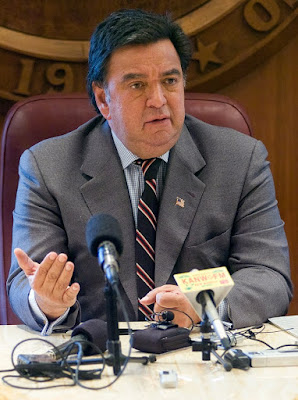 On January 4, 2009, Governor Bill Richardson withdrew his name from consideration when the Federal Bureau of Investigation was unable to forward a report to the Senate Commerce committee for confirmation because his name came up in an grand jury investigation into allegations of possible “pay-to-play” with several of his former high ranking administrative staffers and aides and the Los Angeles based CDR Financial Products, Inc.
On January 4, 2009, Governor Bill Richardson withdrew his name from consideration when the Federal Bureau of Investigation was unable to forward a report to the Senate Commerce committee for confirmation because his name came up in an grand jury investigation into allegations of possible “pay-to-play” with several of his former high ranking administrative staffers and aides and the Los Angeles based CDR Financial Products, Inc.The secret New Mexico federal grand jury was only one of several grand juries across the country investigating government corruption scandals into the possible links between large donations to Richardson’s political campaign and to his nonprofit organizations, "Moving America Forward" and "Si se puede," from donors who received lucrative contracts with the State.
 The United States Attorney for New Mexico Greg Fouratt, above, forwarded the grand jury findings to the Justice Department in Washington, D.C.
The United States Attorney for New Mexico Greg Fouratt, above, forwarded the grand jury findings to the Justice Department in Washington, D.C.Because of the secrecy surrounding a grand jury it is impossible to determine if the panel was used only as a prosecutor’s investigative tool or if they were asked to vote on an any indictments.
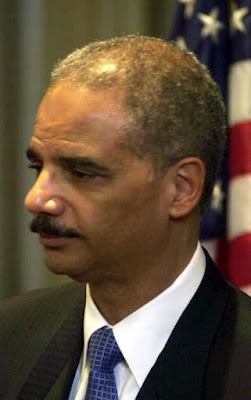 Department of Justice, U.S. Attorney General Eric Holder, above, visited town on June 5, 2009, for a Homeland Security Advisory Council Meeting at the University of New Mexico. Richardson did not attend. Holder refused to entertain any questions related to the grand jury investigation during a press conference, saying he would not even confirm a grand jury’s existence.
Department of Justice, U.S. Attorney General Eric Holder, above, visited town on June 5, 2009, for a Homeland Security Advisory Council Meeting at the University of New Mexico. Richardson did not attend. Holder refused to entertain any questions related to the grand jury investigation during a press conference, saying he would not even confirm a grand jury’s existence.The Department of Justice decided not to pursue any criminal charges.
Richardson’s name was linked through press reports with several other investigations including Illinois Governor Rod Blagojevich who was indicted for multiple counts of corruption. Another investigation in New York involved some of the same individuals and accusations.
 I found this picture of Blagojevich when he sang “Take Me Out to the Ball Game,” as part of the seventh inning stretch during a June 22, 2003, inter-league baseball game between Chicago's crosstown rivals teams, the Cubs and the White Sox.
I found this picture of Blagojevich when he sang “Take Me Out to the Ball Game,” as part of the seventh inning stretch during a June 22, 2003, inter-league baseball game between Chicago's crosstown rivals teams, the Cubs and the White Sox.Former New Mexico Secretary of State Rebecca Vigil-Giron was indicted on 59 counts by a Bernalillo County grand jury for the misuse of millions of federal dollars meant for voter education.
Richardson pushed for "election reforms" including reverting to all paper ballots for the 2006 state elections.
As Secretary of State, Vigil-Giron implemented the all paper ballots. She claimed to have done so with no money and had to go back to the legislature to fund outstanding bills.
Upon being term limited out of office, she was appointed to head the New Mexico Film Museum. When an audit of the Secretary of State's office was begun, the museum job offer was withdrawn and Vigil-Giron was assigned to the State's Department of Workforce Solutions.
More recently critics alleged that Richardson was protecting her employment even after she was indicted.
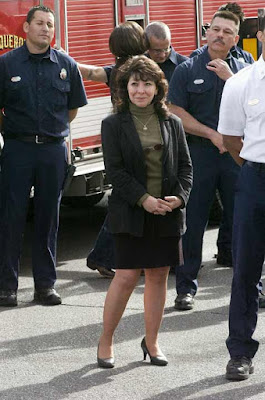 Vigil-Giron, above, a block away from her office, watched her close political ally, Richardson, below center, sign a firefighter health protection bill at Albuquerque Fire Station Number 1 downtown on Silver Ave. S.W.
Vigil-Giron, above, a block away from her office, watched her close political ally, Richardson, below center, sign a firefighter health protection bill at Albuquerque Fire Station Number 1 downtown on Silver Ave. S.W.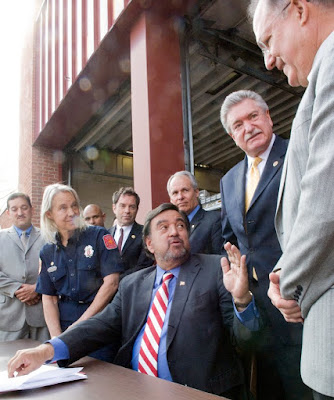 Her name was made public as one of 59 exempt State employees being laid off by order of the Governor's office as part of budget crisis.
Her name was made public as one of 59 exempt State employees being laid off by order of the Governor's office as part of budget crisis. Death of former Governor Bruce King
Death of former Governor Bruce King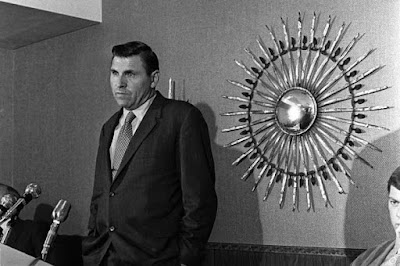 Former three-term New Mexico Governor Bruce King died November 13, 2009. He was 85.
Former three-term New Mexico Governor Bruce King died November 13, 2009. He was 85.King is seen addressing the Albuquerque Press Club during the 1970 gubernatorial campaign against Pete Domenici, which King won.
King was eulogized by former President Bill Clinton at his funeral in Moriarty. Clinton said King mentored him when he was Governor of Arkansas, serving in office beginning in 1979; King’s second term stared at the same time.
 Economy: President Obama Visits Rio Rancho to talk about Credit Card Debt
Economy: President Obama Visits Rio Rancho to talk about Credit Card Debt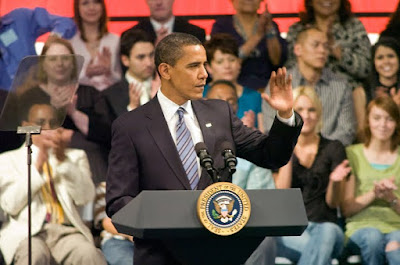 President Barack Obama, above, visited New Mexico speaking at Rio Rancho High School about credit card reform. His speech, in the town hall format, shortly after passing a major economic bailout, was part of the series of laws associated with the stimulus package.
President Barack Obama, above, visited New Mexico speaking at Rio Rancho High School about credit card reform. His speech, in the town hall format, shortly after passing a major economic bailout, was part of the series of laws associated with the stimulus package.New Mexico traditionally economically lags behind the rest of the country, during both recessionary and boom periods.
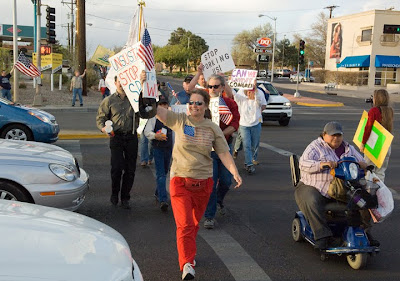 Trying to come to grips and understand the economic situation and government’s role in controlling business, financial, and medical insurance, New Mexico held its own Tea Parties.
Trying to come to grips and understand the economic situation and government’s role in controlling business, financial, and medical insurance, New Mexico held its own Tea Parties.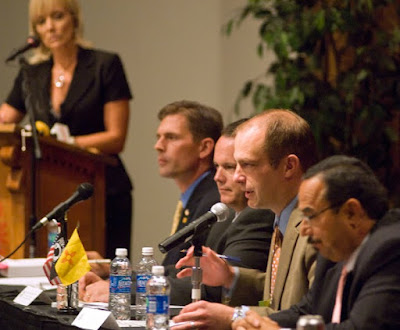 Rookie Democratic Congressman Martin Heinrich, seated left, hosted a Health Care town hall meeting at UNM. The session lacked the incivility of many such gatherings in other parts of the country. The participants, no matter their position, spoke passionately yet eloquently. Much of the credit belongs to the choice of the moderator, former television newscaster Augusta Meyers, left, and the inclusion of a broad spectrum of represented ideas on the panel.
Rookie Democratic Congressman Martin Heinrich, seated left, hosted a Health Care town hall meeting at UNM. The session lacked the incivility of many such gatherings in other parts of the country. The participants, no matter their position, spoke passionately yet eloquently. Much of the credit belongs to the choice of the moderator, former television newscaster Augusta Meyers, left, and the inclusion of a broad spectrum of represented ideas on the panel. Even though there were more than 20 local law enforcement officers, led by APD Chief Ray Schultz, there were no problems requiring legal intervention.
Even though there were more than 20 local law enforcement officers, led by APD Chief Ray Schultz, there were no problems requiring legal intervention. Opening up State Legislature to Sunshine
Opening up State Legislature to SunshineThe 60-day legislative session began with news that leadership of the State Senate, defying their own rule to provide a live video record of floor proceedings, dismantled three recently installed remote-controlled cameras for web casting.
Openness of the legislature became the watchword for the media. Transparency took center stage over all other issues.
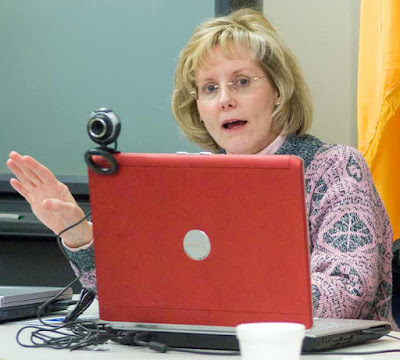 Republican State Representative Janice Arnold-Jones, above, took a web cam into the Taxation and Revenue Committee, and Voters and Elections Committee the hearing rooms bringing a degree of openness by broadcasting her committee’s activities.
Republican State Representative Janice Arnold-Jones, above, took a web cam into the Taxation and Revenue Committee, and Voters and Elections Committee the hearing rooms bringing a degree of openness by broadcasting her committee’s activities.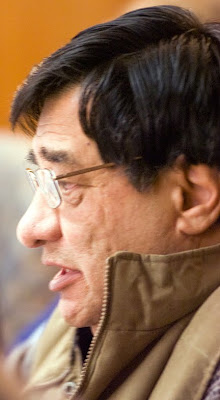 Arnold-Jones stated that House Taxation and Revenue Committee Chair Ed Sandoval, D, Bernalillo, above, said that he didn't ask her to turn off the camera. Rather, he posed the question as a rhetorical statement: if he were to ask her if she would turn the camera off, she wouldn’t would she?
Arnold-Jones stated that House Taxation and Revenue Committee Chair Ed Sandoval, D, Bernalillo, above, said that he didn't ask her to turn off the camera. Rather, he posed the question as a rhetorical statement: if he were to ask her if she would turn the camera off, she wouldn’t would she?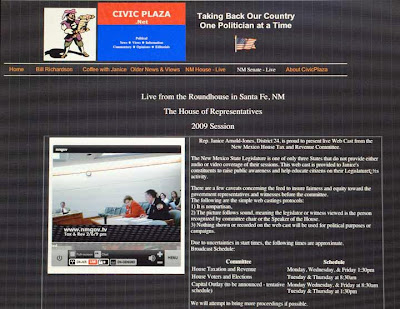 Arnold-Jones said she was going to leave the camera on. Sandoval made no further public issue of the matter.
Arnold-Jones said she was going to leave the camera on. Sandoval made no further public issue of the matter.However, the House leadership, through the Rules Committee took up the issue the next day. Facing a phalanx of press and on-line news bloggers, the committee deferred any action against Arnold-Jones. Over the next few days the House determined their floor proceedings would be webcast in audio form and two other Republican House members began webcasting their committee meetings.
Before the session was over, both houses were providing an audio link of floor activities through legislative websites.
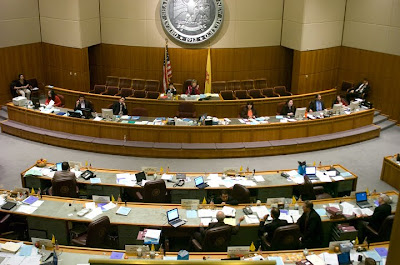 The Senate agreed to reinstall one stationary video camera located in the back of the chamber, a little more narrow view, above, than this image.
The Senate agreed to reinstall one stationary video camera located in the back of the chamber, a little more narrow view, above, than this image.More stories were published or posted on the topic of open government than any other single issue.
 Ched MacQuigg of Diogenes' Six and I collaborated with the New Mexico Independent to video webcast the introduction of all Senate ethics legislation before the Senate Rules committee.
Ched MacQuigg of Diogenes' Six and I collaborated with the New Mexico Independent to video webcast the introduction of all Senate ethics legislation before the Senate Rules committee. We also covered the Senate floor debates of the death penalty, above, and webcasting votes.
We also covered the Senate floor debates of the death penalty, above, and webcasting votes. Arnold-Jones suggested to New Mexico Tax and Revenue Department Secretary Rick Homans and Chairman of the Budget Balancing Task Force, above, that he webcast the meetings.
Arnold-Jones suggested to New Mexico Tax and Revenue Department Secretary Rick Homans and Chairman of the Budget Balancing Task Force, above, that he webcast the meetings.Efforts to webcast were not immediately successful, but by the last meeting the staff had worked out the bugs and 26 people logged on to watch the task force meeting.
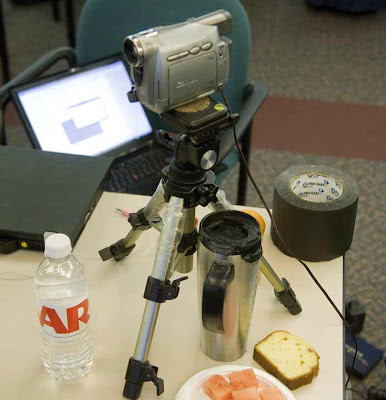
 University of New Mexico scandals
University of New Mexico scandals 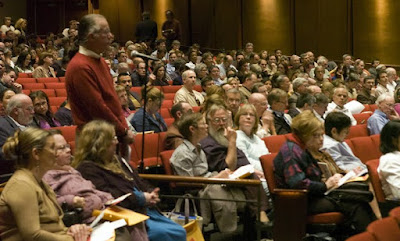 In February the UNM Faculty Senate held a meeting in Popejoy Hall and took a vote of no confidence on the leadership of the university.
In February the UNM Faculty Senate held a meeting in Popejoy Hall and took a vote of no confidence on the leadership of the university. UNM President David Schmidly leaving the stage after he spoke for five minutes defending himself. The faculty voted no confidence of Schmidly by a three to one margin.
UNM President David Schmidly leaving the stage after he spoke for five minutes defending himself. The faculty voted no confidence of Schmidly by a three to one margin.On September 20, 2009, newly hired University of New Mexico Head Football Coach Mike Locksley was involved in a physical altercation with one of his assistant coaches, J.B. Gerald. Gerald filed a police report with the Albuquerque Police Department rather than UNM PD. The incident happened on UNM property. Gerald did not want to press criminal charges.
A week later Peter St. Cyr broke the story.
UNM’s sports department, headed by Athletic Director Paul Krebs handled the events that followed in a ham-fisted manner. There was a poorly executed cover-up. It took weeks and an expose on ESPN cable show, “Between the Lines,” before Locksley was suspended for 10 days.
The local District Attorney failed to step in and bring a misdemeanor charge of simple battery in the name of the people of the State of New Mexico vs. Michael Locksley.
A New Mexico soccer player Elizabeth Lambert, a junior was suspended indefinitely for her physical actions, elbowing, punching and pulling an opposing player to the ground by her ponytail, during a semifinals game with BYU in the Mountain West Conference tournament.
Time Magazine listed Lambert number 10 on their top 10 pariahs, 10. Soccer's Ponytail Yanker.
 Happy New Year!
Happy New Year!
No comments:
Post a Comment